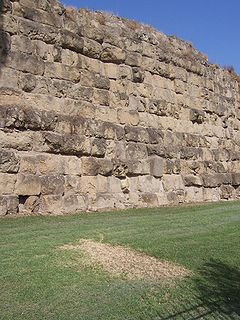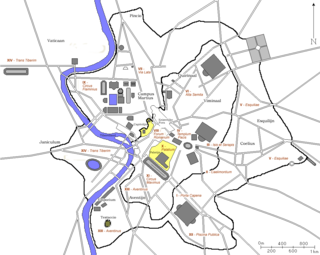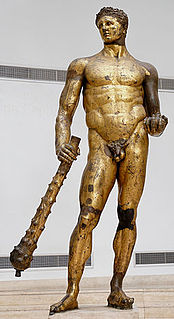
The Roman triumph was a civil ceremony and religious rite of ancient Rome, held to publicly celebrate and sanctify the success of a military commander who had led Roman forces to victory in the service of the state or, originally and traditionally, one who had successfully completed a foreign war.
Libitina, also Libentina or Lubentina, is an ancient Roman goddess of funerals and burial. Her name was used as a metonymy for death, and undertakers were known as libitinarii. Libitina was associated with Venus, and the name appears in some authors as an epithet of Venus.

In ancient Roman religion, Stata Mater was a compital goddess who protected against fires. She had an image (simulacrum) in the Forum, and her cultus, as Festus notes, spread from there throughout the neighborhoods (vici) of the city.

Porta Capena was a gate in the Servian Wall in Rome, Italy. The gate was located in the area of Piazza di Porta Capena, where the Caelian, Palatine and Aventine hills meet. Probably its exact position was between the entrance of Via di Valle delle Camene and the beginning of Via delle Terme di Caracalla, facing the curved side of the Circus Maximus.

The Servian Wall was an ancient Roman defensive barrier constructed around the city of Rome in the early 4th century BCE. The wall was built of volcanic tuff and was up to 10 m (33 ft) in height in places, 3.6 m (12 ft) wide at its base, 11 km (6.8 mi) long, and is believed to have had 16 main gates, though none survive, and enclosed a total area of 608 acres. In the 3rd century CE it was superseded by the construction of the larger Aurelian Walls as the city of Rome grew beyond the boundary of the Servian Wall.

The Ficus Ruminalis was a wild fig tree that had religious and mythological significance in ancient Rome. It stood near the small cave known as the Lupercal at the foot of the Palatine Hill and was the spot where according to tradition the floating makeshift cradle of Romulus and Remus landed on the banks of the Tiber. There they were nurtured by the she-wolf and discovered by Faustulus. The tree was sacred to Rumina, one of the birth and childhood deities, who protected breastfeeding in humans and animals. St. Augustine mentions a Jupiter Ruminus.

In 7 BC, Augustus divided the city of Rome into 14 administrative regions. These replaced the four regiones — or "quarters" — traditionally attributed to Servius Tullius, sixth king of Rome. They were further divided into official neighborhoods.

The Porta Trigemina was one of the main gates in the ancient 4th century Servian Wall of Rome, Italy. The gate no longer exists, but it is frequently mentioned by ancient authors as standing between the north end of the Aventine Hill and the Tiber River, placing it near the southeastern end of the Forum Boarium. The Clivus Publicius descended from the Aventine to the Porta Trigemina.

The Porta Esquilina was a gate in the Servian Wall, of which the Arch of Gallienus is extant today. Tradition dates it back to the 6th century BC, when the Servian Wall was said to have been built by the Roman king Servius Tullius, however modern scholarship and evidence from archaeology indicates a date in the fourth century BC. The archway of the gate was rededicated in 262 as the Arch of Gallienus.

In ancient Roman religion and myth, the Querquetulanae or Querquetulanae virae were nymphs of the oak grove (querquetum) at a stage of producing green growth. Their sacred grove (lucus) was within the Porta Querquetulana, a gate in the Servian Wall. According to Festus, it was believed that in Rome there was once an oakwood within the Porta Querquetulana onto the greening of which presided the virae Querquetulanae.

In ancient Rome, the Piscina Publica was a public reservoir and swimming pool located in Regio XII. The region itself came to be called informally Piscina Publica from the landmark. The piscina was situated in the low-lying area between the Via Appia, the Servian Wall, and the northeast slope of the Aventine Hill, an area later occupied by the Baths of Caracalla.

The Porta Caelimontana or Celimontana was a gate in the Servian Wall on the rise of the Caelian Hill. The Via Caelimontana ran from it; in the late 19th and early 20th centuries, Roman tombs were discovered along its southern edge, some of which have disappeared.

The Arch of Dolabella and Silanus or Arch of Dolabella is an ancient Roman arch. It was built by senatorial decree in 10 AD by the consuls P. Cornelius Dolabella and C. Junius Silanus.

The Porta Fontinalis was a gate in the Servian Wall in ancient Rome. It was located on the northern slope of the Capitoline Hill, probably the northeast shoulder over the Clivus Argentarius. The Via Salaria exited through it, as did the Via Flaminia originally, providing a direct link with Picene and Gallic territory. After the Aurelian Walls were constructed toward the end of the 3rd century AD, the section of the Via Flaminia that ran between the Porta Fontinalis and the new Porta Flaminia was called the Via Lata ("Broadway").
The Lautumiae were tufa quarries that became a topographical marker in ancient Rome. They were located on the northeast slope of the Capitoline Hill, forming one side of the Graecostasis, where foreign embassies gathered prior to appearing before the Roman senate.

In ancient Roman religion and myth, Hercules was venerated as a divinized hero and incorporated into the legends of Rome's founding. The Romans adapted Greek myths and the iconography of Heracles into their own literature and art, but the hero developed distinctly Roman characteristics. Some Greek sources as early as the 6th and 5th century BC gave Heracles Roman connections during his famous labors.

The Porta Querquetulana or Querquetularia was a gateway in the Servian Wall, named after the sacred grove of the Querquetulanae adjacent to and just within it. The grove appears not to have still existed in the latter 1st century BC.
The Alta Semita was a street in ancient Rome that gave its name to one of the 14 regions of Augustan Rome.
The Temple of Pudicitia Plebeia was an ancient Roman temple on the Quirinal Hill, along the Vicus Longus, on what is now via Nazionale. It was dedicated to 'plebeian chastity' and built in 296 BC by Virginia, wife of the future consul Lucius Volumnius, in a section of her own house.
The vicus Patricius was a street in ancient Rome. It began at the Argiletum, ran across the Cispian and the Viminal and ended at the Porta Viminale in the Servian Wall.












